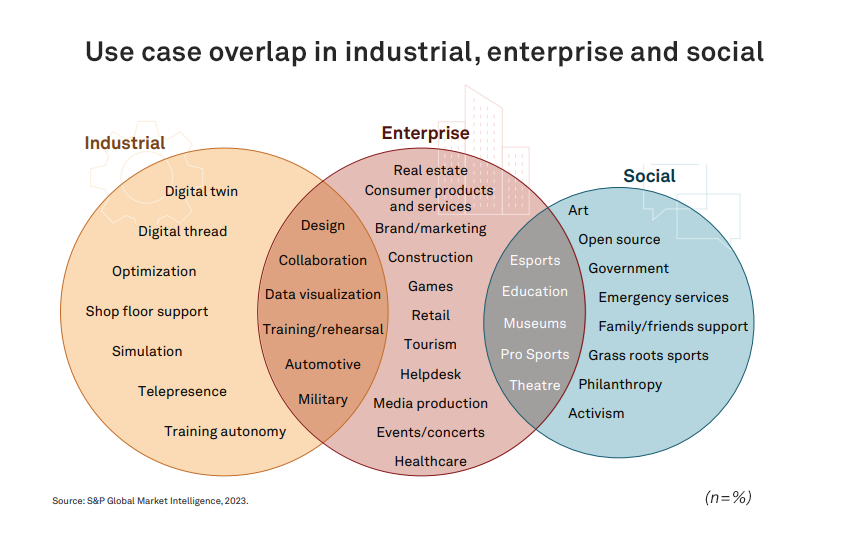
We further divide the environment into industrial, enterprise and social elements. Industrial represents the scientific, engineering and simulation side of the metaverse. Enterprise represents B2B and B2C elements, including employee and customer experience. Social describes those things not directly related to financial or corporate concerns, but that have a metaverse component and relevant use cases. This sphere is also related to the S in ESG. In the chart below, we show some of the major use cases in each of these three zones and how they relate to one another.

Industrial metaverse sphere
Industrial-specific use cases shown above are centered on digital twin and digital thread concepts. An example is the creation of a new factory. Traditionally, a building’s layout and machinery components would be modeled digitally, then that design would become blueprints and paperwork, and the physical build would be made against that paperwork. Once built, staff training and operational plans must be tested and put into action before the factory goes live. The industrial metaverse approach is to build an accurate digital simulation of the to-be-built factory, including how it looks and how it operates.
This environment can be used to validate the design, as well as to train staff and even autonomous robots within it. Once physically built, much of the training and operations planning is already in place, so it can be applied to the physical plant immediately. The design simulation can flow along its life cycle (digital thread) and becomes a live digital twin, with its data kept up to date by IoT instrumentation in the plant. The simulation-trained AI models are deployed into physical robots and continue unaware of the shift from digital to physical. The digital twin can aid in shop-floor processes, providing a place to record or rehearse repairs and mapping machine data in AR during the actual repairs. The same digital twin can also be used in countless “what-if” simulations, such as modeling the performance and economic impacts of potential upgrades, diversifying plant operations, or managing health and safety issues and regulation.
Industrial/enterprise metaverse sphere crossover
Industrial metaverse use cases cross paths with more enterprise-focused use cases when it comes to human-centric activities around collaboration. The ability to meet and engage with people and share data spatially may be more obvious in an industrial context — such as discussing a potential repair or upgrade, or designing a new aircraft wing — having that conversation via avatar standing around a virtual version of the machine, part or system in question. However, this form of interaction can apply to many other types of meeting — from product design to brainstorming and idea generation. From a team culture point of view, the ability to interact in a space offers many more options than a pure video conversation.
Among respondents to 451 Research’s Internet of Things, The OT Perspective, Vendor & Technology Decisions 2022 survey, 39% intend to adopt industrial metaverse technologies in the next few years, and 21% are already doing so. Respondents in the utilities and oil and gas industries report higher current use than other sectors, in part due to the widely distributed nature of those industries, which inclines them to use geographic information systems and remote support applications for field workers.
Enterprise metaverse sphere
The enterprise-specific entries in the metaverse use cases Venn diagram above — those that do not overlap with the industrial category — are largely focused on enhanced user experience in B2B and B2C contexts. One of the most prevalent and visible uses of existing virtual spaces has been as a showcase for brands, typically fashion or lifestyle brands. Experiential technology, such as engaging in a virtual world or game environment, bypasses many of the traditional ways brands have engaged with their markets. Print, web and TV all have interstitial advertising — soap operas, for instance, were named for the detergent advertisements that aired so often during those shows. Film and streaming media have many options for product placement, too. In a user-generated virtual world, there is less potential to force content on users, such as through traditional ad breaks, but much more scope to provide content that users choose to adopt and share. For example, branded virtual clothing may be used on an avatar in multiple places, just as clothing in the physical world is a medium for brand awareness. The metaverse, like all media, will have influential places and people, but it will also have a long tail of community niches. Of course, one factor to consider in this equation is that — for better or worse — digital content is much easier to replicate and make available than physical content.
In 451 Research’s Customer Experience & Commerce, Merchant Study 2022, nearly half of general retail industry respondents expect metaverse to be a high-impact technology in the next three years — well above the 35% survey-wide figure. Those in digital goods and consumer packaged goods are much more likely to project a moderate impact, suggesting they are aware of the potential but may not have fully bought into such a shift.
One key area for metaverse and enterprise is the video game industry. Not all games are metaverse-style applications; many exist for the express purpose of entertaining and provide some degree of narrative. By contrast, metaverse-style applications would support a more open-ended experience incorporating a high degree of user agency.
However, video games make up a several hundred-billion-dollar industry, one that is already surpassing film and music in terms of revenue, and games are increasingly online, long-running services that become venues for nongame events and places for brands to inject content, hitting an otherwise difficult-to-reach digitally native audience.
Enterprise/social metaverse sphere crossover
Sports is one large swath of enterprise that blends with our definition of the nonfinancial social sphere. With professional sports, significant sums change hands in sponsorships, fan merchandise, media rights, team ownership, wages, prize money, stadiums and tracks, and so on. This is fueled by sports fans’ spending and by enterprise sponsorship of every ilk. As a use case, fan engagement in sports is a serious business proposition and is based around play. Hence, it should be no surprise that the sports and video game industries have fused in the form of esports — spectator sports in which the competition is a video game, rather than a physical endeavor such as hitting a ball or driving a car. Esports today is not specifically a metaverse application; it is the playing of video games as a spectator sport and profession. However, as video games are already shared digital experiences, it is an even closer use case than a physical sport to a metaverse future.
Esports still draws spectators, pro and amateur players, and sponsorship revenues. Some esports are purely fantasy video games, while other are closely associated with a pro sport (e.g., the sponsorship and livery in a Formula 1 racing game are officially licensed forms from the physical events themselves rendered in painstaking detail). Esports, like physical sports generally, are based on things people can choose to participate in at a grassroots level, too. The digital football kicked in a FIFA video game is the same for the professional esports teams as it is for anyone buying the game at home. The soccer ball kicked around the in the park for fun is the same kind used in a professional match. Blending physical and virtual and bringing fans together for events, to engage with athletes or to collect merchandise, all fits into the concept of the metaverse.
Social metaverse sphere
The social metaverse sphere entails the use of the metaverse for things that are not specifically about monetization. It does not mean that the services being used are not paid for, but this gives us some space to consider the societal impact of the metaverse. In a truly open, interoperable environment, people will create things for one another and for the greater good. Recall that open-source projects such as the Linux operating system began as a personal goal that turned into a community one to build an operating system. From that has grown an entire industry, but that was not its intent at the start. This leads us to consider other activities for which metaverse applications may be attractive, such as with artists and community projects. Metaverse in this way also applies to activism and government, where groups of people need to communicate, assemble, present ideas or gain support. Just as Linux emerged from open-source community sharing and collaboration, there is potential for significant technical components, standards, protocols, platforms and content to emerge and bypass any corporate investments and intentions.
Metaverse sphere summary
Industrial metaverse can be viewed as a stand-alone area of development given the levels of engineering rigor and accuracy required for accurate simulation. Operational use cases could very well emulate the 1960s space race in the way that science, technology, engineering and computing came together to support that mission and subsequently became used everywhere else. Enterprise metaverse-style collaboration is likely to evolve with additions to already established collaboration tools such as video and chat applications like Microsoft Corp.’s Teams or Zoom Video Communications Inc. Games will remain a major vector for B2C interaction including brand engagement. Sports and esports have two key ingredients — money and consumers — and serious players appear poised to grow metaverse applications in this realm, too.
Want insights on emerging technology trends delivered to your inbox? Join the 451 Alliance.

